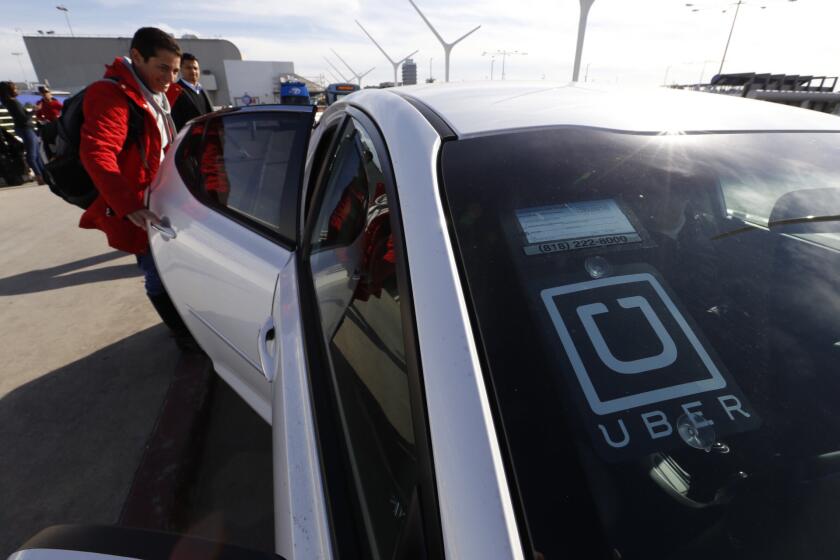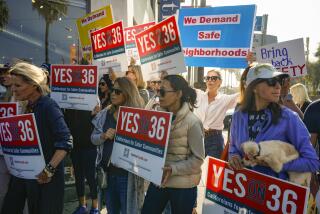Column: Who’s opposing Proposition 15? Land developers and Big Business
The old saying about judging people by the company they keep applies equally to ballot measures.
So let’s take a look at who’s spending the most to fight Proposition 15 on next month’s ballot.
That’s the measure that would close a loophole allowing many commercial and industrial property owners to dodge reassessments under Proposition 13 for some four decades.
According to the most recent disclosures filed with state campaign finance authorities, the big spenders on the “No on 15” side include land developers, agricultural interests and golf and country clubs.
All told, they and other opponents have assembled a war chest of more than $20 million to fight the measure.
This shouldn’t be surprising, because those are among the business interests that have benefited handsomely from the obstacles to reassessing commercial and industrial properties built into Proposition 13.
On the other side, with contributions of more than $30 million, are teacher unions and others who are eyeing the revenue gains of up to $12 billion a year estimated to flow from Proposition 15, of which 60% would go to schools, community colleges and local governments.
A foundation formed by Facebook co-founder Mark Zuckerberg and his wife, Priscilla Chan, has allocated more than $6.3 million to pass the measure, which they say would redress the “profound inequity” in the state’s funding of public services, especially those important to low-income communities.
Could a reassessment of Proposition 13 finally be in the wings?
Proposition 15 is the latest of many attempts to create a “split roll” in the state’s property tax — that is, treating commercial and industrial properties differently from residential properties under Proposition 13. That 1978 measure rolled back property taxes and capped them at 1% of the purchase price, with annual increases in assessed values limited to 2%.
The proposition was pitched as a savior for homeowners who had been getting increasingly gouged by reassessments on property that was soaring in value during that era’s housing boom. But the real beneficiaries were commercial and industrial owners. One reason is that ownership transfers of their properties are easier to obscure than the sale of a house.
Indeed, the annals of California taxation brim with cases in which the sale of a major property was hidden in an elaborate legalistic shell game.
In perhaps the quintessential such deal, the family of computer entrepreneur Michael Dell effectively acquired Santa Monica’s luxury Fairmont Miramar Hotel in 2006 by dividing ownership among himself, his wife and some partners. Because none of them acquired more than 50% of the total, state courts ruled that the changeover couldn’t trigger reassessment.
Another case involved the 1986 deal in which Equitable Life Assurance Co. sold an 81% interest in a San Francisco office complex to an IBM pension plan while retaining formal legal title.
This sale-but-not-a-sale was discovered by San Francisco assessors in 1992, but it took another 14 years for the city to prevail over a welter of lawsuits and appeals. When a state appeals court upheld its assessment in 2006, the bill for taxes and fraud penalties came to $64 million.
Golf and country clubs also benefit from the peculiarities of property taxes in California. The notorious club exemption provides a pass for “equity-membership organizations,” which are effectively owned by their members.
Benjamin Franklin’s adage about death and taxes being the only certainties in this world long has required a footnote in California, where Proposition 13 has been chiseled into the tax structure since 1978.
Then-Los Angeles Assessor Rick Auerbach questioned the assessments of clubs such as the Los Angeles, Brentwood and Bel-Air country clubs, arguing that over time their ownership effectively had changed hands through the buying and selling of memberships.
The state board of equalization, however, issued a legal ruling that piecemeal membership changes didn’t count; a wholesale ownership change of more than 50% at one fell swoop would be necessary to trigger a reassessment. Golf and country clubs have contributed about $300,000 to defeat Proposition 15.
The measure would end such flimflam by requiring that commercial and industrial properties be reassessed at least every three years, effective starting in 2022-23, regardless of whether the property had changed hands. The rule allowing residences to be reassessed only when they’re sold wouldn’t change.
The measure provides for exemptions for businesses with 50 or fewer full-time equivalent employees and owners of less than $3 million in commercial or industrial properties statewide. Nor would it change the tax rate on commercial or industrial properties — that would still be 1% of assessed value, with increases limited to 2% a year.
It’s true that Proposition 15 is far from perfect. But many of its shortcomings exist because its forebear, Proposition 13, turned the state’s property tax system — and by extension its overall tax structure — into a shambles.
By sharply reducing property tax revenue, Proposition 13 heightened the state’s reliance on income taxes, which are highly volatile, especially at the top end, and on sales and excise taxes, which are regressive in that they strike disproportionately hard at lower-income residents.
Proposition 13 also upended the relationship between local governments and the state, by reducing localities’ ability to raise and spend their own tax revenues and turning them into supplicants to Sacramento for the funds they needed.
Residents lost much of their influence over local budget priorities; streets went unpaved and school programs shrank, because decisions about them were being made in the state Capitol instead of the town hall. That contributed to skepticism about local government that afflicts the state to this day.
Get ready for a torrent of special-interest spending on California ballot measures.
Proposition 15 won’t fix any of that. But it will help to redress the increasing imbalance in the share of state revenues provided by businesses versus residents. Over the last four decades, the burden of property taxation has shifted decisively toward residential owners from commercial and industrial properties.
In Los Angeles County, for example, single-family residences accounted for 39.9% of assessed values and commercial-industrial properties for 46.6% in 1975. By 2018, the ratio had more than reversed, with single-family houses accounting for 57.6% and commercial-industrial real estate for 28.9%.
Proposition 13 may not be solely responsible for that trend. But it certainly has allowed big property owners to avert massive tax bills over the years by retaining their 1970s-vintage assessed valuations. Disneyland, for instance, hasn’t faced a comprehensive reassessment since Proposition 13, even as the price of admission has gone from $7.30 per person to $154 per person, rising at more than four times the rate of consumer inflation.
(To be fair, the park has been modernized and the old system of ticket books limiting access to the most popular rides was scrapped in 1982 in favor of a single admission price, which now varies by time of year.)
As I’ve written before, the state’s assessors hate the proposition because it would saddle them with a workload many say would be impossible to manage without years of preparation — more than the three-year transition period implied by the measure. In part that’s because the skills needed to assess commercial and industrial properties have drained away over the years, since they weren’t needed.
Los Angeles County Assessor Jeffrey Prang told me that if Proposition 15 passes, he would need to add about 500 additional commercial and industrial appraisers and 250 additional support personnel to his current cadre of 600 appraisers to perform regular appraisals of L.A. County’s 150,000 commercial and industrial properties.
Each new hire would need a year of classroom training and another apprenticeship year in the field, plus perhaps three years more to gain the skills for commercial appraisals, Prang says.
Agriculture interests say the proposition doesn’t recognize their unique business structures or their reliance on prices for commodities that are related to national or global prices and that they therefore can’t control.
Although the measure exempts land and ground crops such as lettuce, broccoli and strawberries, they say it leaves fruit and nut trees, as well as barns and other “improvements,” vulnerable to steep increases in property tax.
It’s time to close a big tax loophole for businesses
Growers are “going to get killed by reassessments,” says Robert Speigel, policy advocate for the California Farm Bureau Federation, “especially if they happen to be dairy, livestock, vineyard or winery.” The agriculture industry has collected roughly $3 million in contributions to fight Proposition 15, according to the latest filings with the California Secretary of State.
The drafters of the measure say growers are exaggerating their exposure to tax increases, since it’s possible, even likely, that implementing rules crafted by the Legislature will provide them with greater exemptions.
The opponents of Proposition 15 have mounted a campaign to scare voters into thinking that the split roll will be a stalking horse for residential property tax increases and will drive up the cost of “just about everything we need and use, like food, utilities, day care and healthcare.”
Their argument is that property owners will simply pass through the tax increases to consumers dollar for dollar. But of course things are never that simple. Prices of goods and services are dependent more on competition and quality than taxes.
Property taxes are complicated, especially since Proposition 13 created chaos in the state system. What’s clear about Proposition 15, however, is that business interests — whether real estate owners and developers, golf clubs or farm owners — know that it would close a loophole that they’ve enjoyed for four decades.
The ultimate target of Proposition 15 is the inequity buried in a property tax structure that was poorly thought out in `1978, has gotten more out of whack ever since, and becomes less serviceable with every day that passes. Political leaders have been terrified to revisit Proposition 13 for far too long, and it’s about time that voters took the task in hand at the ballot box.
More to Read
Inside the business of entertainment
The Wide Shot brings you news, analysis and insights on everything from streaming wars to production — and what it all means for the future.
You may occasionally receive promotional content from the Los Angeles Times.













